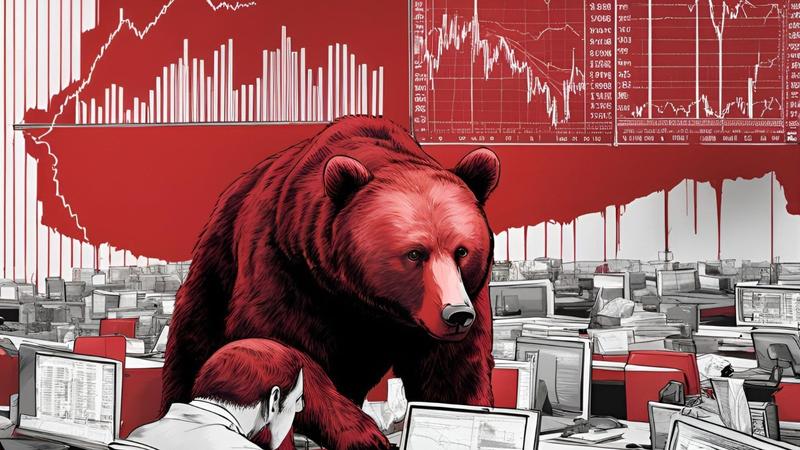Published 16:02 IST, January 13th 2025
Bears Have A Field Day On D-Street; Markets Crash As Sensex Tanks 1,000 Points, Nifty Slips Below 23,100 - Key Factors
Indian equity markets plunged on January 13 as the Sensex nosedived over 1,000 points and the Nifty broke below the 23,100 level.

The Indian stock markets faced a steep decline on January 13, with the BSE Sensex crashing 1,001.95 points (-1.29%) to close at 76,376.96, and the NSE Nifty slipping 343.05 points (-1.46%) to finish at 23,088.45.
Market Meltdown: Sensex and Nifty Tumble
Notably, the Nifty ended below the psychologically crucial level of 23,100. This marked a sharp reversal for equities amid intensifying global and domestic challenges.
Sectoral and Stock Performance
Every sectoral index on the Nifty ended in negative territory, with Nifty Realty emerging as the worst performer, followed by Media, Auto, and Pharma. Among Sensex constituents, Zomato , PowerGrid, Adani Ports, Tata Steel, NTPC, and Tata Motors led the declines. For the Nifty, Adani Enterprises, Trent, BPCL, BEL, and PowerGrid were the top laggards.
Key Factors Driving the Sell-Off
“The domestic markets drifted lower for the fourth consecutive trading session, wherein market sentiments have been driven by four key variables,” explained Sugandha Sachdeva, Founder of SS WealthStreet.
“The first one being the persistent FII outflows where they have offloaded nearly Rs 21,357.46 crore since the beginning of this calendar year. This follows a substantial Rs 1,97,000 crore in net outflows since the end of September, weighing heavily on market sentiment.”
Global Pressures Weigh on Markets
The sharper-than-expected rise in US nonfarm payroll data for December has dampened hopes for imminent Federal Reserve rate cuts. This has raised concerns about tighter monetary policy, which weighed heavily on investor sentiment. “The Nifty fell for the fifth session in six Friday, with a break of Thursday's so-called Tweezer bottom showing just how weak the market is,” noted Akshay Chinchalkar, Head of Research at Axis Securities. “The area between 23,177 and 23,355 will continue to matter on the way down, while immediate resistance stands at 23,600.”
“Another key reason is the blowout US payrolls data for December, underscoring the strength of the labour market and reducing the likelihood of a rate cut by the US Fed in 2025. This has dampened global risk appetite and added to the bearish momentum,” Sachdeva said.
Market expert Ajay Bagga provided additional context, stating, “Global markets are facing a 'lose-lose,' risk-off battering. As the Friday US Jobs report showed a strong US economy, the markets reacted as 'good news as bad news.' The strong US economy meant that the US central bank, the Federal Reserve, will not need to do further rate cuts for many months now. That led to US bond yields firming up to nearly two-year highs and the US dollar strengthening. Higher US yields and falling local currencies have led to a major 'risk-off' sentiment globally.”
Domestic Headwinds: Crude Oil and Rupee Weakness
On the domestic front, a record surge in crude oil prices added inflationary pressure, while the Rupee ’s continued slide against the US dollar exacerbated market concerns. The Indian currency plunged 27 paise to a lifetime low of 86.31 against the dollar.
Sachdeva highlighted the other two key reasons as the sharp surge in the Dollar Index, which has risen to 110 levels, a two-year peak. “This increases the cost of investing in emerging markets like India and has further pressured domestic equities as a stronger dollar often leads to capital outflows,” she added.
The third factor is spiralling crude prices. “Crude oil prices have risen by more than 8% month-to-date. The Biden administration's fresh sanctions on Russia’s oil and gas sector, one of the world’s top producers, have exacerbated supply constraints and fueled inflationary fears,” Sachdeva noted.
‘The rise in global crude oil prices as the outgoing Biden administration announced stricter sanctions on over 180 entities that deal with Russian crude oil exports. The Rupee opened weak and fell to all-time lows, reflecting the weak global sentiment and the strong US dollar,’ said Bagga.
Foreign Investor Exodus
Foreign institutional investors (FIIs) pulled out Rs 4,285 crore from Indian equities in the first three trading sessions of January, driven by high valuations and concerns ahead of the third-quarter earnings season. This followed net inflows of Rs 15,446 crore in December, highlighting the shift in sentiment amid mounting global uncertainties.
‘FPIs have continued to sell in the Indian stock markets in 2025, and that is another overhang on the markets. The market correction today also enveloped the mid-cap and small-cap indices, indicating that the selling pressure has broadened further,’ added Bagga.
Looking Ahead
“Going ahead, all eyes would be on Trump’s policies after his swearing-in ceremony on January 20, the US Fed meeting towards the end of this month, corporate earnings, and the Union Budget , which will further dictate the direction of markets,” said Sachdeva.
The combination of global economic concerns and domestic challenges has left Indian equity markets in a precarious position. The upcoming earnings season and key economic data releases, such as the December Consumer Price Index (CPI) and Producer Price Index (PPI) in the US, are likely to play a crucial role in determining market direction. Investors remain cautious as inflationary pressures, crude price volatility, and a weakening rupee continue to weigh on sentiment.
Updated 16:27 IST, January 13th 2025